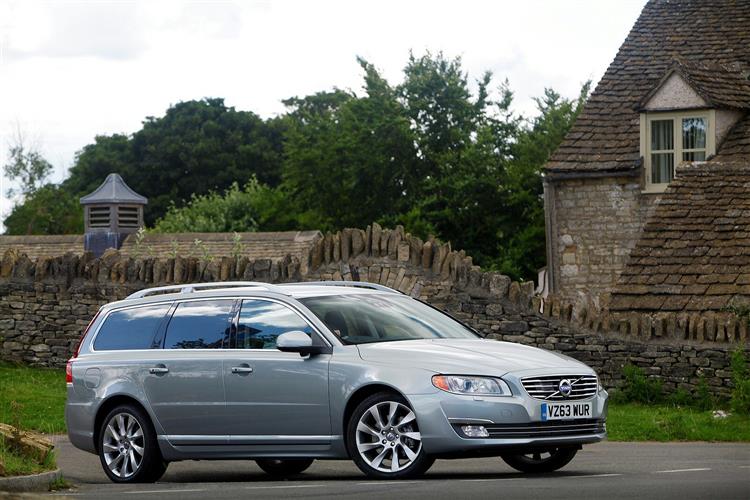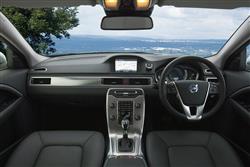SUEDE AND SQUARE (some text hidden) --NONE--
By Jonathan Crouch
Introductionword count: 127
Before the advent of people carriers, sports utility vehicles and crossovers, if you wanted a vehicle with a serious amount of space inside, you need a large Volvo estate. From the turn of the century, Gothenburg's large station wagon was badged 'V70' for the modern era and continued to be as uncompromisingly big and practical as ever, bridging the gap between medium range Mondeo-sized estates and the very largest fully-fledged Executive-shaped station wagons. Here, we're going to focus on the very last MK3 V70 variants produced between 2013 and 2016. Choose your model carefully from this era and you'll get yourself a car fitted with Volvo's efficient 'Drive-E' engine technology. With that kind of powerplant beneath the bonnet, a used V70 can make a lot of sense.
Modelsword count: 7
5dr estate (1.6, 2.0, 2.4 diesel [D2,D3,D4,D5])
Historyword count: 223
Volvo has a long and illustrious heritage in producing spacious estate cars, one which stretches all the way back to 1953 and the Duett PV445 wagon. That was replaced with the classic Amazon model in 1962 which in turn gave way to the 145 series in 1967, but the big Volvo estate that many remember is the big-bumpered 245/265 series of 1974, the car that upwardly mobile Margo and Jerry Ledbetter drove in the BBC sitcom 'The Good Life'. Every middle class Surbiton couple had to have one. So did every antiques dealer. In 1985, we got the ugly US-inspired 740/760 models, restyled in 1990 and sold as the 940/960 series. Only with the introduction of front wheel drive in the 850 estate of 1993 however, did things really take a step forward, a car re-launched as the V70 in 1996. The first proper purpose-designed V70 followed in 2000, replaced in 2007 by the third generation version. That MK3 model was heavily updated in 2010 with a package of changes that carried the V70 through to the post-2013 period where Volvo was able to start plumbing in some of its own engines rather than using Ford-derived units. It's the 2013 to 2016 period V70 models we're going to look at here. In 2016, the V70 was finally replaced b the all-new V90 model.
What You Getword count: 1072
As a brand, Volvo's design language has become significantly more trendy in recent years, but with this V70, the approach was more cautious. For one thing, the brand felt that loyal buyers of this model wouldn't hold with ultimate carriage capacity being compromised in the way it had had to be with the brand's slightly smaller V60 range. Producing a more dynamic shape would have run the risk of alienating them, with no guarantee of attracting those who would normally shop for an Audi or a BMW. So the practical, square-backed silhouette that most people expect any big Volvo estate to offer remained here, with its bluff, vertical tailgate. Look a little closer though and the careful details please, like the way that the climbing waistline creates a forward-leaning, dynamic stance that's further reinforced with the help of the black pillars between the side windows. Small aesthetic changes were made to these later MK3 V70 models, but you'd really have to know this Volvo model line very well to appreciate them. Owners of earlier third generation models may notice the smarter front grille with its larger brand badge, the Daytime Running Lights and the added chrome touches that aimed to give the car a more upmarket and luxurious feel. The rear end meanwhile, featured a completely redesigned bumper, along with smarter tail lights. Overall though, with these last V70 models, Volvo wasn't diverted from this car's raison d'etre - lugging gear. Raise the tailgate (power assistance was offered to original owners as an option) and a 575-litre boot is revealed. True, that might not be as much as you'd get from, say, estate versions of the Volkswagen Passat or the Skoda Superb but there's still quite as much room here as any normal family, equestrian rider or antique dealer will ever need. Let us put Volvo's case over in practical terms: there's room enough here for a washing machine with all its packaging or, according to the Swedish brand, five large suitcases plus an extra medium one and two rucksacks. If you're going to be carrying heavy items regularly, try and find a V70 whose original owner specified the optional load-compensating suspension option. Just as important is the way you can use all that space. We especially like the shallow hinged compartment on the top of the boot floor. Lift up the flap and you can mess up that floor with muddy stuff. Then when you remove your wellies or whatever, the flap goes down again and you don't have to worry about cleaning the cargo area carpet. Well not immediately anyway: out of sight, out of mind and all that. Original buyers could also specify a reversible waterproof mat to cover the entire base of the luggage area. But if you have this feature and put the mat down, then you won't be able to use the aluminium rails and movable anchoring points that are featured on a cargo area floor. Original buyers could specify this floor in sliding form to help them get heavy items in and out more easily. Practical touches include a handy flip-up load divider to restrain smaller objects, plus you'll also find luggage nets and hooks to help secure any items with wayward tendencies. There's a 40:20:40 split in the rear bench so that long items like skis can be poked through, one of no fewer than 16 different loading combinations. And if you completely flatten the rear bench (a process that as an option can be electrically powered), up to 1,600-litres of space is freed up if you stack to the roof. If that still isn't enough, then there's a fold-forward front passenger seat so you can take longer items like kayaks and surfboards. So it's good for packages. But what about for people? Take a seat in the rear and you'll find that three fully-sized adults will just about fit comfortably, enjoying decent standards of leg, head and knee-room, as well as neat vents in the B-pillars. For parents, Volvo offered original buyers the useful option of two integrated child booster cushions, one on each side of the rear seat. Where fitted, these can be set at two different heights, thereby accommodating a wide range of child weights and ages. Slip behind the wheel and you'll be treated to an example of Scandinavian design at its very best with this car's trademark super-slim floating centre console, simple instruments and switchgear ergonomics that are a match for anything from Audi or Mercedes. The idea is that, like IKEA furniture, this cabin should be typically Scandinavian, comfortable, simple, intuitive and visually pleasing. A subtle redesign for these later V70 models introduced smarter materials and silk metal frames around the air vents and light controls, plus a re-designed gear knob and lovely touches like a frameless rear view mirror. Our only gripe lies with the rather fiddly electronic handbrake. One of the nicest touches that original buyers could shell out a little extra for was the hi-tech TFT instrument display. With the flick of a switch, this presents the driver with the choice between three different dial layouts - an amber back-lit 'elegance' setting for comfort-orientated day-to-day motoring, an green back-lit 'eco' setting to help you drive more economically and a red back-lit 'performance' mode to better suit for more spirited driving. That'll be new to buyers who may have owned an early version of this third generation model. As will be the clever 'Sensus Connect' infotainment system with its 7-inch colour screen. As a driver, you've the choice of going online either via a car-mounted 3G/4G dongle or by using your own mobile phone. Hi-tech features include a voice-activation system that works on all music sources and the industry's first in-dash, fully integrated, voice search Spotify application. It's also possible to share a WiFi network with everyone in the car. Of course, it's possible to get carried away with gadgetry like this and forget more crucial considerations. The seats for example. It's remarkable how little importance we attach to the things we'll be sitting on in our cars, given that we'll be spending many hundreds or thousands of hours in the things, and down the years Volvo has quietly earned a reputation for making the comfiest chairs in the business. This V70 continued that form line with what have to be the most supportive yet wonderfully pillowy seats in the executive estate sector from this era.
To see the full road test text contact us on 0330 0020 227
Pictures (high res disabled)

.jpg)
|
.jpg)
|
.jpg)
| |||
.jpg)
|
.jpg)
|
.jpg)
| |||

|
Scoring (subset of scores)
Category: Luxury Saloons and Estates
| Performance | |
| Handling | |
| Comfort | |
| Space | |
| Styling, Build, Value, Equipment, Depreciation, Handling, Insurance and Total scores are available with our full data feed. | |



